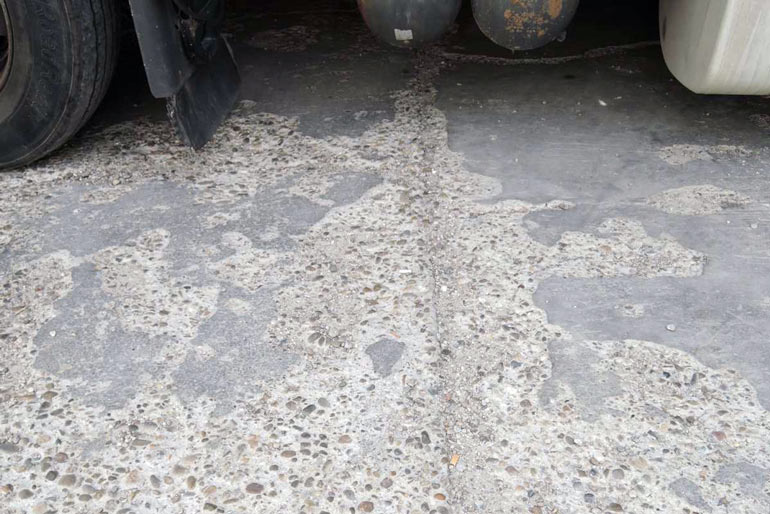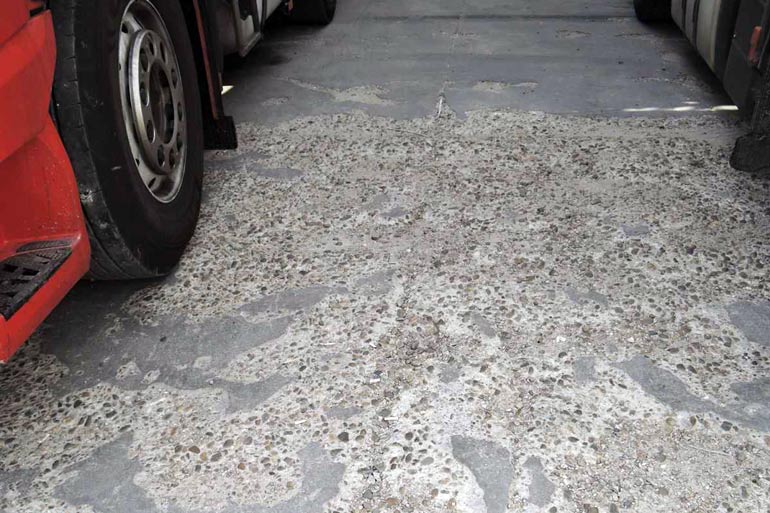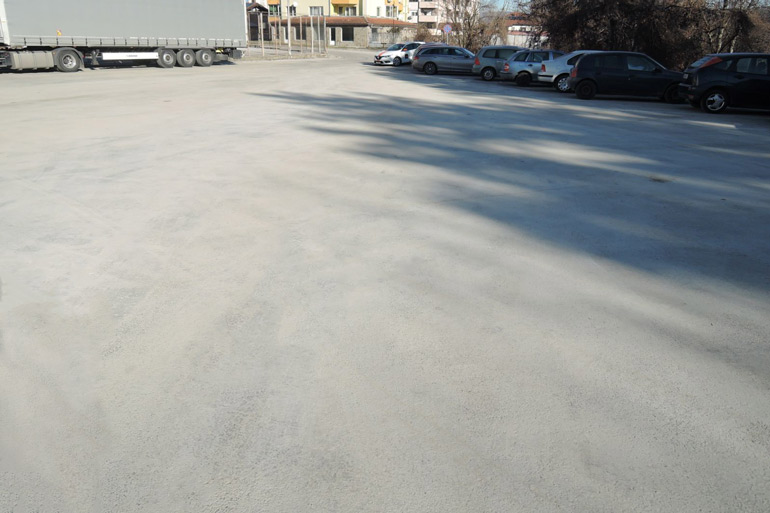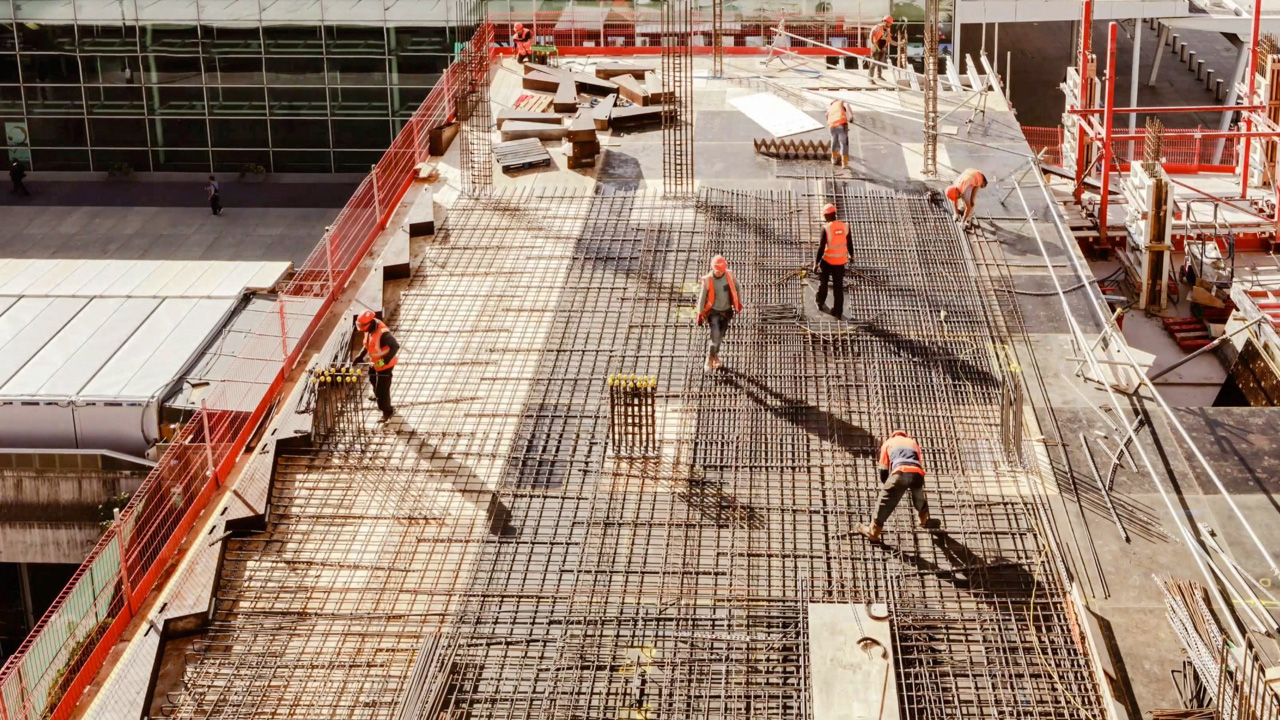Description
It is possible, with just one additional step during the construction of the asphalt pavement. This is how one of the leading textile manufacturers in Europe preserved its investment by restoring the destroyed concrete pavement in just a few hours, without stopping the factory processes.
Product used: Asphalt-cement pavement DRACOBIT®
Imagine a production plant that is the heart of an industrial zone, stretching over dozens of acres of land. The investment is large, as are the maintenance costs, especially for the pavements, which are daily crossed by trucks and lorries carrying heavy loads.
In addition, imagine that the climate in our country, with its wide annual temperature range, tests every construction and especially every industrial outdoor pavement.
And, as if that wasn't enough, the heavy trucks, moving slowly, maneuvering, with small turning radii, starting, stopping, load the pavements many times more than any heavy vehicle flying on the highway at high speed...
Limited budget and short deadlines suggest solutions that are a critical combination of conditions when it comes to projects of this scale. Usually, financial resources are directed towards the construction of production buildings and the purchase of equipment, while the surrounding pavement is made at the end, as quickly as possible and with limited funds.
The decision of what type of pavement to choose - asphalt or concrete, is based on the available local resources, especially in areas with an underdeveloped construction industry. The main criterion for the choice is the lowest price of the final product, as well as the time for laying, but without much focus on the durability of the performance characteristics.
Undoubtedly, each of the two types of pavements has its advantages and disadvantages. We are witnessing that asphalt pavements, although relatively unpretentious for laying, suffer to a greater extent from the temperature range of operation (rutting, wrinkling, extrusion, cracking) compared to concrete pavements, which, if done correctly, have a long life, but are more complex in terms of installation conditions.
Anyway, a decision was made, with the scales tipping in favor of concrete.
The project was completed on time, the work of the plant started, but not long after, the investors and owners faced some inconveniences that the choice of concrete brought with it. The continuous daily traffic of slowly moving and maneuvering trucks, delivering raw materials and transporting the manufactured goods, create a serious load on the pavement, eroding the surface layer. This, in combination with the cycles of freezing and thawing of water that has penetrated into the concrete, accelerates the processes of destruction.
 |
 |
Repairing concrete pavements in the traditional way, by milling and pouring a new layer of concrete, is an expensive process that requires special products, experience and knowledge. Placing an additional asphalt layer on the concrete not only masks the problems, but also creates new ones related to the sensitivity of the asphalt to high temperatures in the summer months, which makes it easily deformable, leading to cracking and rutting.
On the other hand, low temperatures in winter cause freezing of water that has penetrated through the permeable asphalt, which destroys it and peels it off from the concrete surface. The result is the need for constant patching.
This continuous cycle of repairs and maintenance not only takes time and resources, but also puts serious limitations on the operational efficiency of the enterprise. In this context, the search for a sustainable and effective solution is more than inevitable.
Now imagine that the same production plant has an asphalt pavement that, however, has the characteristics and strength of concrete and the advantages of asphalt, but is accessible to car traffic only 48 hours after laying. A new technology, developed to cope with the challenges of crumbling industrial pavements and which gives the prospect of a more sustainable and productive working environment.
This was the challenge faced by a plant in the heart of Bulgaria, a leading company in the production of home textiles in Europe and one of the largest companies in the country. The continuous repairs of the external pavements, disrupting the work cycle, cause not only serious losses for the investors, but also the need to spend time and attention on non-core activities. This is the reason why they decided to look for a long-term solution to the problem.
Our task was to offer the owners a solution that would stop the cycle of destruction and repair of the pavements, in which they were involuntarily involved, while ensuring the long-term operation and guarantee of their investment.
For the first time in Bulgaria, the innovative DRACOBIT® technology was offered, which has been successfully used in projects such as ports, airports and other facilities around the world.
DRACOBIT® is a special pre-mixed product based on inorganic components and additives used to obtain a super-fluid filling mixture with compensated shrinkage.
The process of building the asphalt-cement pavement is easy, fast and does not differ significantly from the laying of a standard asphalt pavement - first a bituminous primer is applied, then the drainage asphalt layer, and then DRACOBIT® is applied.
The main advantages that convinced the owners of the plant that DRACOBIT® is their solution were:
- NO JOINTS, MAXIMUM DURABILITY: The lack of joints (which are often the weakest zones) contributes to the strength and durability of the pavement, eliminating one of the main factors causing destruction.
- FLEXIBILITY AND DURABILITY: DRACOBIT® combines the flexibility of asphalt with the high mechanical strength of the cement mortar.
- EXCELLENT RESISTANCE TO STATIC AND DYNAMIC LOADS: DRACOBIT® is ideal for work on large surfaces exposed to intensive traffic, dynamic loads and aggressive environments.
- FAST APPLICATION: DRACOBIT® is characterized by very fast application, while being ideal for maintenance and repair work in hard-to-reach areas.
- PUT INTO OPERATION ONLY AFTER 48 HOURS: DRACOBIT® saves the inconveniences caused by stopping the movement of cars and pedestrians. Only 48 hours after laying the product, the pavement is open to traffic.
- RESISTANT TO FREEZE-THAW CYCLES: DRACOBIT® does not change its properties even when working in large temperature ranges, from - 50°C to + 90°C.
- EXCELLENT PRICE-QUALITY RATIO: Thanks to its high performance and easy application, DRACOBIT® is ideal for restoring existing floor coverings at a low cost.
With DRACOBIT®, the asphalt pavement withstands the loads that production facilities have every day, without showing signs of wear or tear. Even in extreme climatic conditions - high temperatures in summer and negative temperatures in winter, the pavement constructed with a layer of DRACOBIT® remains strong and does not change its characteristics.
This successful project is yet another proof of the possibilities of modern technology to change and improve industrial processes, providing a more sustainable and efficient infrastructure.
And no, these technologies are not for the "brave", but for those who know how to grow.








